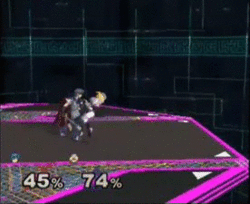Pivoting: Difference between revisions
mNo edit summary |
mNo edit summary |
||
| Line 1: | Line 1: | ||
{{ArticleIcons|ssb=y|ssbm=y|ssbb=y}} | {{ArticleIcons|ssb=y|ssbm=y|ssbb=y}} | ||
[[File:Marth pivot fsmash.gif|thumb|250px|{{SSBM|Marth}} pivoting a forward smash.]] | |||
'''Pivoting''', or '''DA Dashing''', is the use of the [[frame]] at which a character turns during a [[dash-dancing|dash-dance]], in which any normal ground options are available as if the character were standing still — [[smash attack|smashes]], [[grab]]s and [[tilt attack|tilts]] can occur here without the [[lag]] that usually comes from using these attacks after a [[dash]]. Normal pivoting is primarily used so that a character can quickly change the direction they are facing whilst not suffering the usual [[turn]]-around lag that would occur when doing so. This can allow characters to improve the utility of various moves in certain situations. | '''Pivoting''', or '''DA Dashing''', is the use of the [[frame]] at which a character turns during a [[dash-dancing|dash-dance]], in which any normal ground options are available as if the character were standing still — [[smash attack|smashes]], [[grab]]s and [[tilt attack|tilts]] can occur here without the [[lag]] that usually comes from using these attacks after a [[dash]]. Normal pivoting is primarily used so that a character can quickly change the direction they are facing whilst not suffering the usual [[turn]]-around lag that would occur when doing so. This can allow characters to improve the utility of various moves in certain situations. | ||
Revision as of 10:28, August 25, 2014

Pivoting, or DA Dashing, is the use of the frame at which a character turns during a dash-dance, in which any normal ground options are available as if the character were standing still — smashes, grabs and tilts can occur here without the lag that usually comes from using these attacks after a dash. Normal pivoting is primarily used so that a character can quickly change the direction they are facing whilst not suffering the usual turn-around lag that would occur when doing so. This can allow characters to improve the utility of various moves in certain situations.
Special moves can also be pivoted (or reversed). In Smash 64, pivoting a special simply involved using the move while holding the control stick in the opposite direction the character is facing. In Melee with the introduction of side special moves, pivoting was a little more difficult to pull off, especially on the ground. Most neutral special moves are automatically pivoted depending on the user's momentum. For example, Falco will reverse the direction in which he fires his Blaster shots if he has jumped backwards. In Brawl, all special moves can be pivoted (excepted for Mario's F.L.U.D.D.) by pressing the B button and immediately pushing the control stick in the direction opposite whichever one the character is facing. While Captain Falcon's and Ganondorf's neutral special moves, the Falcon Punch and Warlock Punch respectively, can be pivoted normally, doing a slightly delayed pivot will have an animation of them actually turning around to perform the punches, dealing even more damage and knockback, but performing them slower as a result. The punches are officially known as reverse Falcon/Warlock punches, and the term "reverse" is often used by players in general, especially when referring to up specials (this is also the case in Melee). Pivoting special attacks can help with movement, especially in the air, as some characters carry momentum when they pivot (such as R.O.B. with his Gyromite and Diddy Kong with his Peanut Popgun, which upon pivoting is automatically canceled).
In Brawl, grabs that are pivoted are called pivot grabs.
The tactic was discovered by Philly Billy.
